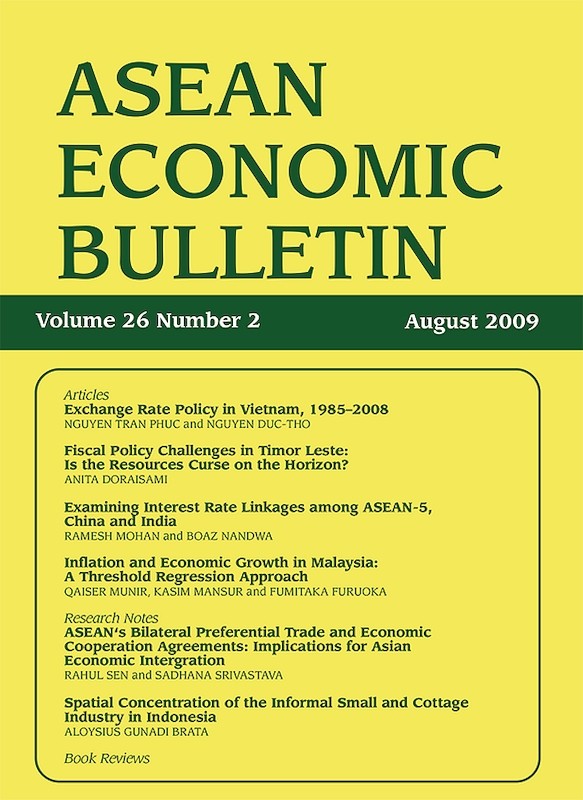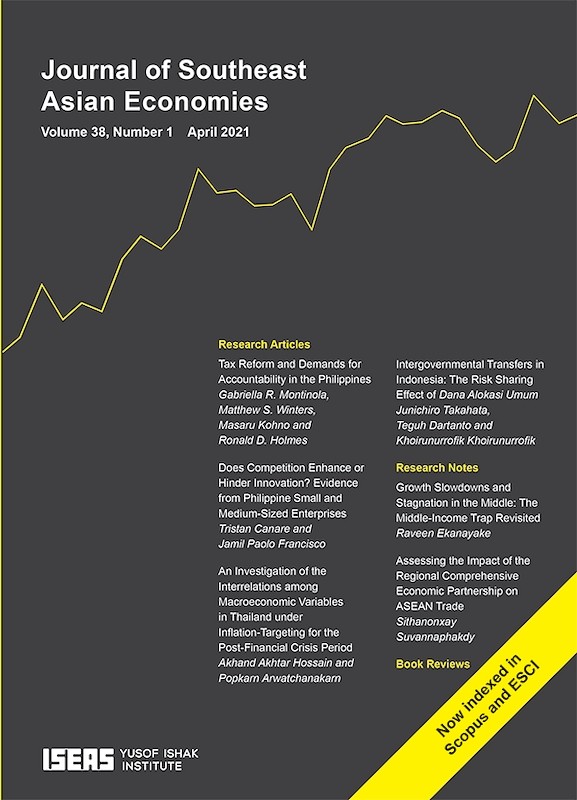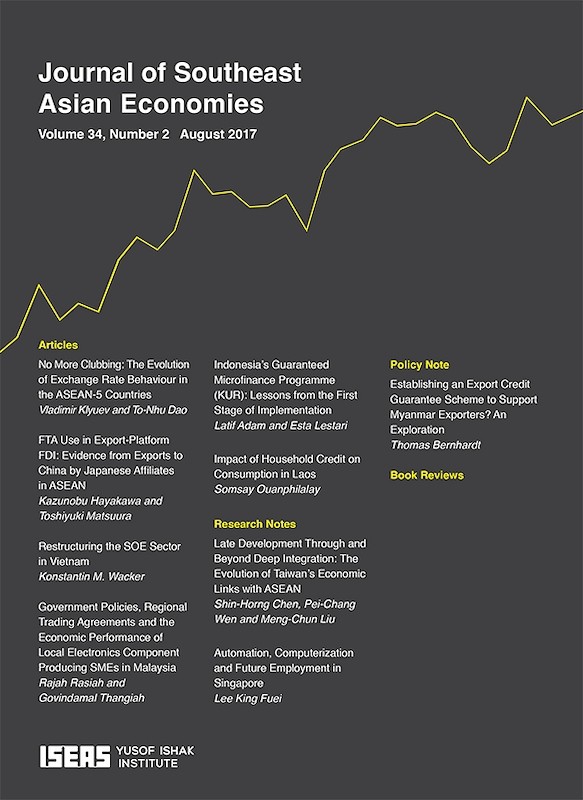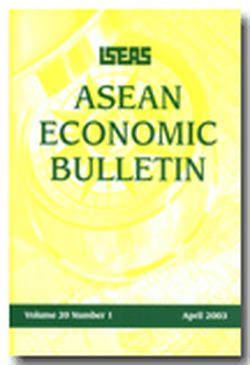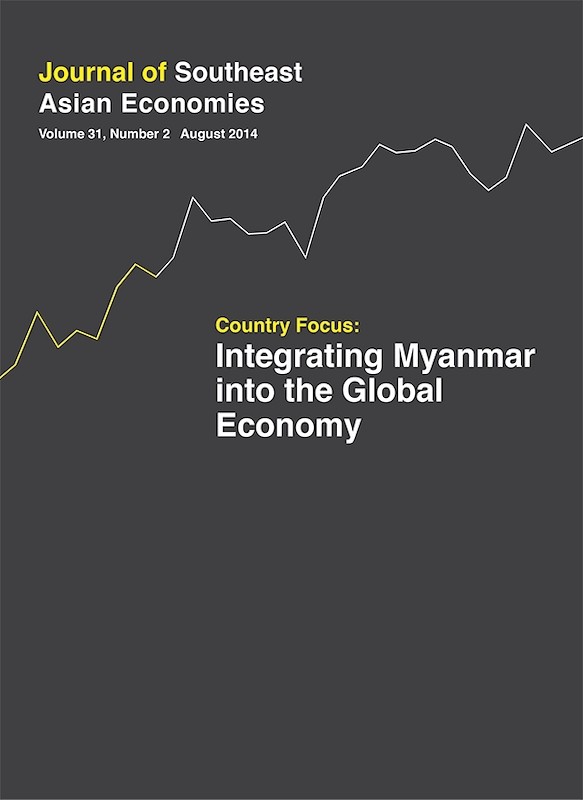ASEAN Economic Bulletin Vol. 24/3 (Dec 2007)

Date of publication:
December 2007
Number of pages:
96
Code:
AE24/3
Contents
-
ASEAN Economic Bulletin Vol. 24/3 (Dec 2007)
[Whole Publication] -
Preliminary pages
- ARTICLES
-
Determinants of Parallel Exchange Rate in Myanmar, by Koji Kubo, author see abstractThis paper analyses determinants of the parallel exchange rate in Myanmar. A time series analysis confirms the following points: first, there is a co-integration relationship between the consumer price index and the parallel exchange rate, which is compatible with the general perception that the chronic depreciation is due to the monetization of fiscal deficits. Second, business fluctuations largely accounted for the changes in the parallel rate in the short term, whereas natural gas revenues did have little effect. On the other hand, given the structure of the parallel exchange market, the disparity between the official and the parallel rates per se appears to exert little impact on the private sector.
-
Trade Structure and Trade Flows in Cambodia: A Gravity Model, by Norak Huot, Makoto Kakinaka, authors see abstractThis paper studies Cambodia's bilateral trade flows through investigating the impact of trade structure in a framework of the gravity equation over the period 2000-2004 after its entry into the ASEAN Free Trade Area (AFTA). The measure of trade structure is constructed by the degree of trade complementarity between Cambodia and its trading partners. The empirical results show that a higher degree of trade complementarity is associated with a higher level of trade flows. This could be consistent with a Heckscher-Ohlin model in that factor endowment difference between the countries, which is captured by the measure of trade structure, is a dominant driving force for trade flows. Some related implications are also discussed.
-
The Narrow Money Demand Behaviour in Indonesia, 1970-2005, by Akhand Akhtar Hossain, author see abstractThis paper specifies a simple partial adjustment model of narrow money demand for Indonesia in an open economy context and estimates it with annual data for the period 1970-2005. Empirical results suggest that real income, inflation (a proxy for expected inflation), and the return on foreign financial assets are the major determinants of narrow money demand in this country. The deposit rate of interest (a proxy for the interest rate on alternative domestic financial assets) is statistically insignificant. The CUSUM and CUSUMSQ of residuals tests suggest that the narrow money demand function remained stable during the sample period of study. Having selected an empirically parsimonious model, both the recursive and rolling regression techniques are applied to investigate the possibility of structural change in the regression coefficients possibly due to financial reforms and innovations since the early 1990s. Empirical results suggest that since the late 1990s the long-run income elasticity of the demand for narrow money has remained relatively stable around a value not different from one while the narrow money demand elasticities with respect to the rates of inflation and the return on foreign financial assets have declined markedly. The paper interprets the overall empirical results in a historical context and draws implications on the strategy of monetary policy in Indonesia.
-
Go with the Gang, ASEAN!, by Sasatra Sudsawasd, Prasopchoke Mongsawad, authors see abstractThis study investigates the unexplored trade potentials and the economic impacts of bilateral free trade agreements (FTAs) between ASEAN-5 member countries (Indonesia, Malaysia, Philippines, Singapore, and Thailand) and the seven-candidate FTA partners (Australia, India, Japan, New Zealand, South Korea, and the United States.) By using the gravity model and the Computable General Equilibrium (CGE) model, this study suggests the strategic FTA partners of ASEAN-5: ASEAN plus 3 FTA, ASEAN-China FTA, ASEAN-US FTA, ASEAN-Japan FTA, and ASEAN-India FTA. Moreover, this study shows that ASEAN-5 would achieve more benefits from the FTAs if they fully liberalized trade among themselves partly due to less trade diversion, better resource allocation, and terms-of-trade effect improvement. The results clearly indicate the potential gains from the intra-regional free trade, and point towards the importance of the ASEAN regional cooperation.
-
An Empirical Examination of East Asia's Pre-Crisis Pegged Exchange Rates, by Joseph Dennis Alba, Donghyun Park, authors see abstractWe specify appropriate models for the behaviour of East Asian economies' pre-crisis daily bilateral exchange rates vis-a-vis the U.S. dollar and explore systematic relationships among those exchange rates. Our preliminary analysis indicates that the rupiah, baht, and Hong Kong dollar are stationary against the U.S. dollar. Unlike major currencies, the rupiah, peso, and won do not exhibit volatility clustering vis-a-vis the dollar. We also find evidence of systematic relationships that are consistent with contagion during the 1997 Asian crisis. The distinctive characteristics of East Asia's exchange rates were due to capital controls. Our findings lend some support to the region's post-crisis moves towards more flexible exchange rates.
- BOOK REVIEWS
-
BOOK REVIEW: Islamic Banking and Finance in South-East Asia: Its Development and Future, by Angelo M. Venardos., by Karyn Wang, author
-
BOOK REVIEW: Managing Globalization: Lessons from China and India, edited by David A. Kelly, Ramkishen S. Rajan, and Gillian H. L. Goh., by Toshiki Kanamori, author
-
BOOK REVIEW: The Inclusive City: Infrastructure and Public Services for the Urban Poor in Asia, edited by Aprodicio A. Laquian, Vinod Tewari, and Lisa M. Hanley., by Robert L Curry, Jr., author
-
BOOK REVIEW: Malaysia: From Kampung to Twin Towers, by Richard Leete., by Anita Doraisami, author
-
BOOK REVIEW: Beyond the Green Myth: Borneo's Hunter-Gatherers in the Twenty-First Century, edited by Peter Sercombe and Bernard Sellato., by Lee Poh Onn, author


